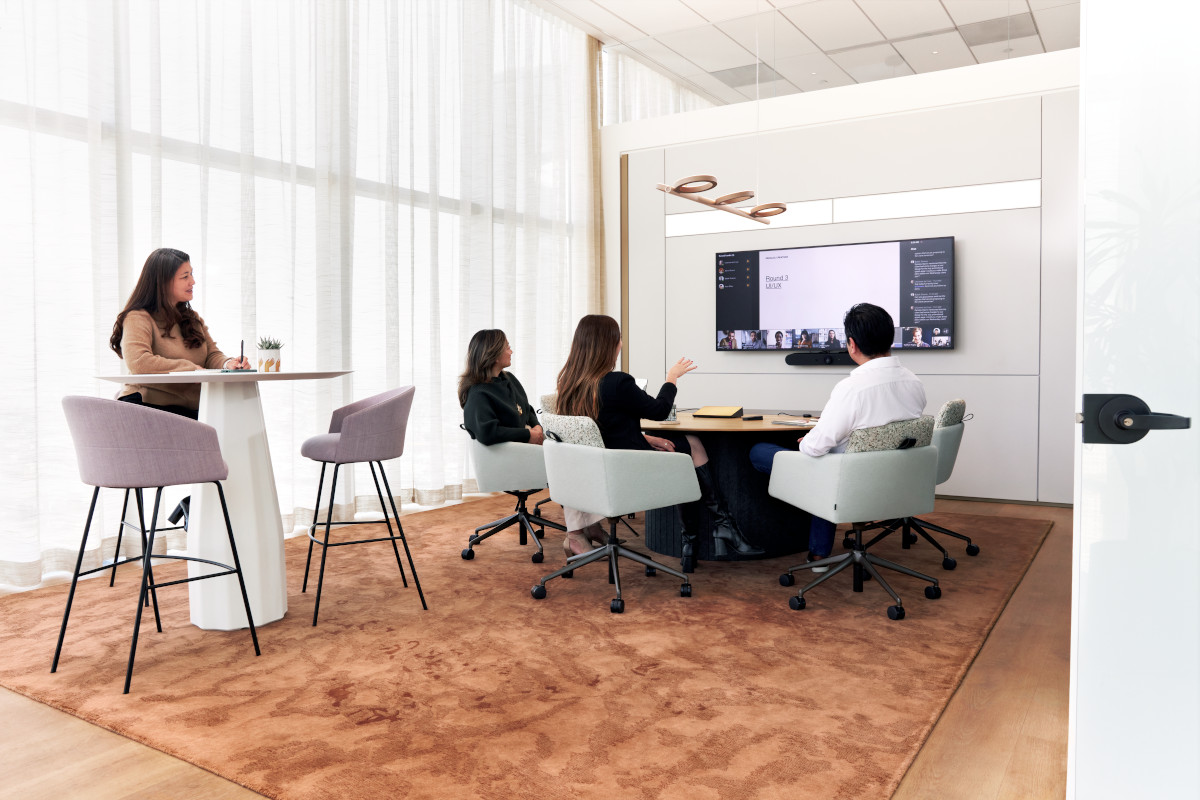We use cookies to maximize your online experience with us. By closing this window, you consent to our cookie policy. You can change your cookie settings in your browser any time. For more information, please see our Privacy Policy located on the footer of this site.
How to Integrate Audio Conferencing Systems for Seamless Hybrid Meetings
 The challenges of ineffective audio during virtual meetings are readily apparent—intermittent sound, muffled voices, and distracting echoes can leave participants feeling frustrated and disconnected from their teams.
The challenges of ineffective audio during virtual meetings are readily apparent—intermittent sound, muffled voices, and distracting echoes can leave participants feeling frustrated and disconnected from their teams.
That’s why many organizations are turning to trusted partners like DBE Systems, who specialize in engineering and installing high-performance audio-conferencing solutions tailored for hybrid work environments. A dancker brand, DBE Systems is the company’s technology arm, charged with designing and integrating custom solutions that eliminate common audio issues and create a more unified, productive meeting experience. Technologies employed by the DBE Systems team empower better connectivity and communications for both in-office and remote teams.
As hybrid work models become the norm, companies must prioritize audio clarity and reliability to ensure that virtual meetings flow as naturally as in-person conversations. The following guide will walk you through how to successfully integrate a modern audio-conferencing system—with expert support from DBE Systems—to future-proof your hybrid workplace.
Why Audio Quality Matters in Hybrid Meetings
Poor audio quality significantly hinders productivity within a hybrid work environment, where team members are in varying locations, both on-site and remote. The importance of clear and reliable audio is often underestimated. Here are some key reasons.
1. boosts productivity
Clear audio is essential for smooth and productive meetings. Quality sound ensures teammates aren’t constantly repeating or clarifying themselves. This keeps conversations focused and helps teams make decisions more quickly.
As a result, instead of wasting time troubleshooting sound issues, everyone can concentrate on the actual work at hand. High-quality audio also contributes to a more inclusive meeting experience for both in-office and remote participants.
2. Engages Everyone, Including Remote Teams
Remote team members in hybrid meetings inherently face a disadvantage by not being physically present in the room. If their audio experience is suboptimal, they can easily feel excluded and less engaged.
This is the impact of poor audio: It inadvertently allows in-office employees to dominate conversations while remote participants struggle to follow along. High-quality audio, however, creates a more equitable environment, ensuring everyone an equal opportunity to contribute.
When remote employees can hear clearly, they are better positioned to participate meaningfully in discussions and feel like valued members of the team.
3. Gives Your Brain a Break
Experiencing poor audio quality can be both frustrating and mentally taxing. The feeling of exhaustion after a virtual meeting with inadequate sound often stems from the brain’s increased effort to decipher what was being said.
This additional cognitive load can lead to stress, fatigue, and reduced focus. High-quality audio mitigates this strain, allowing participants to remain engaged without unnecessary mental fatigue.
4. Makes You Professional
While some clients may be understanding of minor technical issues in a virtual meeting, many will not. Subpar audio can often create an impression of unpreparedness and a lack of professionalism. For instance, if an investor perceives an inability to conduct a seamless meeting, it may lessen their confidence in entrusting you with their business and financial resources.
Professional-grade audio enhances your credibility. It demonstrates respect for everyone’s time and an appreciation for effective communication, two qualities that never go unnoticed in the business world.
 Steps to Integrate an Audio-Conferencing System
Steps to Integrate an Audio-Conferencing System
Integrating an effective audio conference system involves more than simply connecting a microphone and joining a meeting. While not overly complex, certain steps must be performed correctly to ensure the system functions properly.
Here is a step-by-step guide for integrating an effective audio-conferencing system.
Step 1: Assess Your Current Setup
Before investing in advanced equipment, take the time to evaluate your current setup. Assess which elements are functioning effectively and which are presenting challenges.
- Identify the specific audio issues faced, such as echo, low volume, or background noise.
- Determine the size of your team.
- Consider the environments from which your team members will be joining: remote locations, a large conference space, or smaller meeting rooms.
Different systems are designed to address varying needs. For example, a large conference room accommodating numerous participants may require noise-canceling technology and ceiling-mounted microphones. Conversely, a small team within a quiet office setting may only require a high-quality speakerphone.
Pro Tip: Conduct a test call utilizing your existing setup and ask for feedback from remote participants. Their insights can highlight issues that may not be readily apparent within the physical meeting space.
Beyond ensuring audio clarity, verify the compatibility of any new system with your current hardware, including speakers and microphones. The goal is to avoid potential and costly complications in the future.
Rooms with hard, reflective surfaces like glass or concrete often suffer from excessive reverberation, while insufficient soundproofing or insulation can allow noise to travel through walls and disrupt privacy. By integrating acoustic wall panels and/or ceiling baffles, we can enhance clarity and reduce sound transfer. Our team also provides acoustic analysis to assess existing spaces and develop tailored remediation solutions for optimal performance.
Step 2: Select the Right Audio Solution
With a clear understanding of your requirements, it’s time to invest in the appropriate equipment. Selecting microphones and speakers is critical to the overall audio experience. Prioritize high-quality products that offer superior clarity.
Your chosen audio solution should be able to adapt and expand along with your team, including supporting a growing number of remote participants and additional microphones as necessary. Consider using beamforming microphones for larger conference rooms where single microphones are insufficient.
Finally, ensure your solution is compatible with your organization’s video conferencing software and certified for platforms like Google Meet, Zoom, and Microsoft Teams.
Step 3: Partner with an Integration Expert
While setting up an audio-conferencing system can be a fun DIY project, not everyone has the technical expertise for self-installation. Many things can go wrong if not executed properly. That is why partnering with an expert like DBE Systems makes all the difference.
DBE Systems offers professional installation and engineering of custom hybrid work solutions tailored to your unique needs and space. When you team up with dancker and DBE Systems for audio integration, you get the following:
- A tailored strategy, rather than a generic, one-size-fits-all solution.
- Seamless coordination of infrastructure, furniture, and technology to accommodate the selected audio solution.
- Ongoing support to ensure the consistent and reliable operation of your meetings.
- Seamless integration with your existing technology platforms.
Step 4: Testing and Optimization
Discovering an audio malfunction in your new system during an important client call can be both disruptive and create an unfavorable impression with your client. Therefore, before deploying your new system, thorough testing is essential to identify and resolve any potential issues.
- Conduct test meetings to evaluate microphone coverage and audio clarity.
- Fine-tune microphone sensitivity settings to ensure voices are heard clearly and minimize background noise.
- Optimize software settings—enabling features such as spatial audio, noise suppression, and echo cancellation—for an enhanced audio experience.
Consistent performance of even the best audio systems requires regular maintenance. Establish a schedule for periodic system updates to improve performance, prevent operational glitches, and incorporate new features as they become available.
DBE Systems – Your Partner for Hybrid Audio-Conferencing
At DBE Systems, we use our expertise and innovative technology solutions to transform your conferencing vision into reality.
Why choose us?
- We understand that no two businesses are alike. That’s why we deliver innovative solutions tailored to your unique needs.
- Our systems feature superior sound quality with advanced noise suppression and echo cancellation features. We aim to eliminate distractions and enhance communication.
- As your business grows, DBE’s scalable solutions evolve with you. From small Team Huddle Rooms to large Operation Centers, we design purpose-built rooms that support today’s workers.
- Our systems are compatible with existing IT setups, such as Zoom and Microsoft Teams. Thus, you don’t have to worry about downtime or technical issues.
Upgrade your audio-conferencing systems with DBE Systems and let your team focus on collaboration, not connectivity issues.
 Benefits of a Seamless Audio-Conferencing System
Benefits of a Seamless Audio-Conferencing System
A well-integrated audio-conferencing system is a game-changer. Here are the key benefits.
1. Improved Meeting Clarity and Participation
Successful communication in a hybrid work environment begins with high-quality audio. It effectively bridges the gap, creating a more unified meeting experience.
As a result, team members can contribute freely, knowing their voices will be clearly heard. This minimizes awkward pauses and delays, leading to more inclusive, collaborative, and productive meetings.
2. Reduced Technical Difficulties
Few things are more disruptive to the start of a meeting than spending the first twenty minutes troubleshooting audio issues. An efficient audio system will identify and eliminate any potential problems before they occur.
By minimizing these technical disruptions, teams can save valuable time, alleviate unnecessary stress, and prioritize effective communication.
3. Enhanced Hybrid Team Collaboration and Productivity
Poor audio can slow down the decision-making process. When participants must constantly repeat points, meetings take longer than anticipated, causing productivity to plummet.
A high-quality audio system enhances clarity in conversations, meaning fewer interruptions. By eliminating the need for participants to strain or repeat themselves, team members are more likely to remain engaged and contribute to the conversation.
Ultimately, improved audio leads to sharper team focus, fewer delays, and meetings that conclude on schedule.
Conclusion
The success of any hybrid meeting is fundamentally dependent on its audio quality. Even excellent video quality cannot compensate for poor sound. If participants experience difficulty hearing one another, overall productivity will suffer.
Implementing proper integration steps is vital for eliminating frustrating audio issues and creating a seamless meeting experience.
With dancker and DBE Systems as your trusted partners, you are guaranteed high-quality audio solutions tailored to your unique needs. Contact DBE Systems to get started.
